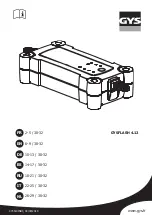
C
H A R G E R
O
N E
3
The Charger One is now ready to charge. Plug the rechargeable battery into the Charger One
and charging will start automatically. The first line of the display shows: "
battery type
charge".
From left to right, the second line of the display shows the following:
Charging voltage in Volt (V)
Charging current in Ampere (A)
Capacity of battery charged in in Ampere hours (Ah)
Note:
The actual capacity of a rechargeable battery can only be measured by fully discharging
the battery. The given value displayed by the Charger One is the acual amount of capacity the
battery has taken during that specific charge cycle. When the battery is full this value
(capacity) will be most likely be higher than the specified capacity of the battery and will not
nessesarily reflect the actual capacity available when the battery is discharged. Please keep
this in mind if you want to calculate burn times.
The capacity charged is a guide as to how far through the charging cycle the battery is. For
example, if an 8.2Ah battery shows a charged capacity of 4.1Ah, it is approximately 50% full.
During the charging procedure, the Charger One monitors the battery voltage and capacity.
The charger will adjust the charging voltage and current based on these values and the
charging program to ensure the battery is correctly charged and maintained.
The charging current will increase rapidly to 2.5 A when charging an almost empty
rechargeable battery (battery voltage well below 8.2 V) and will continue to charge at 2.5A for
most of the cycle.
When the battery reaches a certain level (or when charging a partly discharged battery), the
battery voltage will reach 8 V and the charging current will be decreased to below 1.0A . At
this time the battery will be almost full.
At this time it is possible to remove the battery from the charger and the capacity will almost
be full. The final stages of charging are at a low current to ensure the battery is 100%.
Finally, when the battery has been fully charged with a low charging current (less than 1.0A),
the charger switches to impulse prerservation charge (Ni-MH) or off (Li-Ion). The display will
show: "
battery type
pulse" or "
battery type
full."
After charging the rechargeable battery can be used immediately. Due to the high discharging
rate of Ni-MH batteries, Lupine recommends keeping these types of rechargeable batteries
plugged to the charger for storing. This will prevent the battery from over discharging if stored
for a long period of time (over 3 months).
Ni-MH batteries can become "lazy" after several weeks/months of being connected to the
charger but this is easily overcome after two or three charge/ discharge cycles (also, see
paragraph "pushing" below). It is far better to have a lazy battery which can be recovered than
an over discharged battery which cannot be recovered and must be replaced.


























